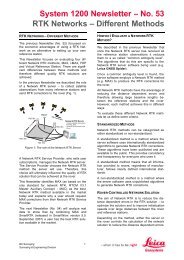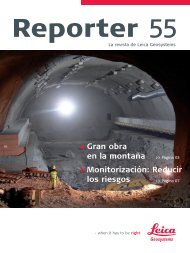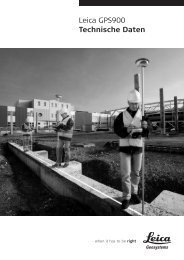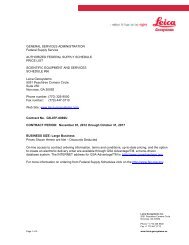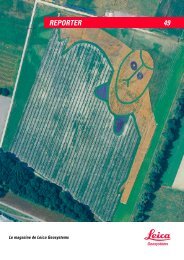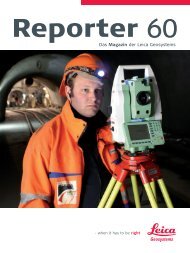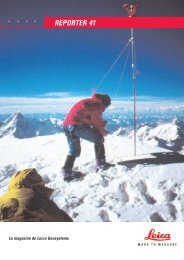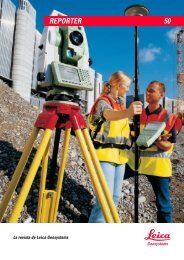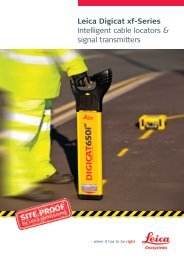Reporter No 60, May 2009, English (PDF 2,58 MB) - Leica ...
Reporter No 60, May 2009, English (PDF 2,58 MB) - Leica ...
Reporter No 60, May 2009, English (PDF 2,58 MB) - Leica ...
You also want an ePaper? Increase the reach of your titles
YUMPU automatically turns print PDFs into web optimized ePapers that Google loves.
crude oil into a useful petroleum product, efficiently<br />
and with environmental care. A critical phase of this<br />
conversion is called hydrotreating and/or hydrocracking,<br />
the process that removes sulfur and other contaminants<br />
from refinery products.<br />
Cianbro's job is to fabricate Motiva's advanced<br />
hydrotreater and hydrocracker units, along with other<br />
modules for the expansion project. This task creates<br />
approximately 500 local, quality jobs and contributes<br />
significantly to Maine's economy.<br />
As a start, Cianbro converted its 39-acre (150 m²)<br />
Eastern Manufacturing Facility located along the<br />
Penobscot River in Brewer from an idle paper mill<br />
into a state-of-the-art modular fabrication yard.<br />
The jobsite includes a sprawling crushed rock yard,<br />
sidewalk-grade concrete slabs and giant hydraulic<br />
cranes designed to lift the steel beams and columns<br />
that eventually frame each modular section. A 500-<br />
square-foot (46.5 m²) module fabrication pad is able<br />
to accommodate up to 20 modules simultaneously.<br />
The administration building encloses 12’000 square<br />
feet (111.5 m²), and a heavy haul road leads to the<br />
barge bulkhead.<br />
Tight tolerances<br />
Each refinery module is a prefabricated, self-standing<br />
steel structure approximately four stories tall.<br />
It is constructed of steel beams that create the<br />
frame upon which pipes, valves, pumps and wiring<br />
are pieced together to form a catalytic-cracker-feed<br />
hydrotreater, and hydrocracker units.<br />
Before the fabrication begins, a team of work package<br />
engineers at Cianbro's Eastern Manufacturing<br />
Facility dissects detailed 3D diagrams of the refinery<br />
units, drawings that are provided by the owner. The<br />
team builds work packages for each module, using<br />
3-D Construct Sim software. The work packages consist<br />
of isometric drawings that detail weld types, pipe<br />
specifications, and 3D spatial data. Once a module's<br />
work package is complete, fabrication begins.<br />
At each module staging pad, construction crews<br />
position transport beams and vertical column base<br />
plates that form the foundation of a unique module.<br />
The horizontal transport beams are positioned four<br />
to five feet above the ground so that the hauling<br />
trailers can slide under the module, lift it and carry it<br />
to the shipping dock upon completion.<br />
Cianbro's field engineers use two <strong>Leica</strong> TCRA705<br />
reflectorless total stations tied to the Maine state<br />
plane coordinate system to monitor every module<br />
fabrication pad continuously. Once the beams and<br />
columns are in place, engineers are able to verify<br />
that the structural steel tolerances of 3/8 " (9.5 mm)<br />
>><br />
The Global Magazine of <strong>Leica</strong> Geosystems | 15



